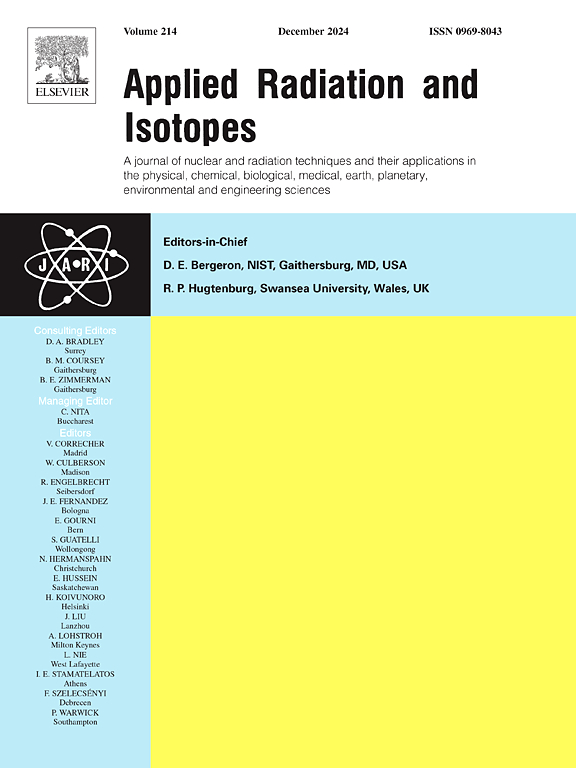IF 1.6
3区 工程技术
Q3 CHEMISTRY, INORGANIC & NUCLEAR
引用次数: 0
摘要
在这项研究中,对伊拉克消费的二十种品牌奶粉中天然放射性核素(222Rn、226Ra、238U、214Po 和 218Po)的α发射体浓度进行了测量,以确保食品安全。使用 CR-39 固态轨道探测器监测氡含量及其女儿。结果显示,奶粉中来自氡-222、镭-226、铀-238、钋-214 和钋-218 的阿尔法发射体浓度范围分别为 28.4 至 112.5 Bq/m3、0.09-0.35 Bq/kg、0.012-0.983 ppm、8.8-0.5 Bq/kg、0.012-0.983 ppm、0.012-0.983 ppm。检测室壁上的平均浓度分别为 59.7 Bq/m3、0.19 Bq/kg、0.107 ppm 18.5 Bq/m3 和 10.0 Bq/m3。这些研究结果表明,阿尔法辐射体浓度的平均值低于世界标准。我们也计算了样本的一些与健康风险评估有关的参数,包括三组样本的年有效剂量、终生致癌风险和不同身体器官或组织的有效剂量率。结果发现,奶粉样本中成人、儿童和婴儿的年平均有效剂量分别为 0.008、0.014 和 0.060 μSv/y。奶粉样本中成人、儿童和婴儿一生中患癌症的平均超额风险分别为 0.031 × 10-6、0.056 × 10-6 和 0.232 × 10-6。结果表明,食用这些样本是安全的。本文章由计算机程序翻译,如有差异,请以英文原文为准。
Investigation of alpha emitters and health risk assessment in powdered milk samples consumed in Iraq using SSNTDs
In this study, alpha emitter concentrations of natural radionuclides (222Rn, 226Ra, 238U, 214Po, and 218Po) were measured in twenty brands of powdered milk consumed in Iraq to ensure food safety. CR-39 solid-state track detector was used to monitor radon levels and their daughters. The results show that alpha emitter concentrations from radon-222, radium-226, uranium-238, polonium-214, and polonium-218 in powdered milk ranged from 28.4 to 112.5 Bq/m3, 0.09–0.35 Bq/kg, 0.012–0.983 ppm, 8.8–34.8 Bq/m3 on the chamber wall, and 4.8–18.9 Bq/m3 on the detector surface, with the mean concentrations of 59.7 Bq/m3, 0.19 Bq/kg, 0.107 ppm 18.5 Bq/m3, and 10.0 Bq/m3 respectively. As a result of these studies, the mean values of alpha emitter concentrations were below the world standard. Some parameters related to health risk assessment have also been calculated for samples, including annual effective dose, excess lifetime cancer risk, and effective dose rate to different body organs or tissues for three groups. The mean annual effective dose for adults, children, and infants in the powdered milk samples have been found to be 0.008, 0.014, and 0.060 μSv/y, respectively. The mean excess lifetime cancer risk for adults, children, and infants in the powdered milk samples 0.031 × 10−6, 0.056 × 10−6, and 0.232 × 10−6 respectively. Results indicate that the consumption of these samples is safe.
求助全文
通过发布文献求助,成功后即可免费获取论文全文。
去求助
来源期刊

Applied Radiation and Isotopes
工程技术-核科学技术
CiteScore
3.00
自引率
12.50%
发文量
406
审稿时长
13.5 months
期刊介绍:
Applied Radiation and Isotopes provides a high quality medium for the publication of substantial, original and scientific and technological papers on the development and peaceful application of nuclear, radiation and radionuclide techniques in chemistry, physics, biochemistry, biology, medicine, security, engineering and in the earth, planetary and environmental sciences, all including dosimetry. Nuclear techniques are defined in the broadest sense and both experimental and theoretical papers are welcome. They include the development and use of α- and β-particles, X-rays and γ-rays, neutrons and other nuclear particles and radiations from all sources, including radionuclides, synchrotron sources, cyclotrons and reactors and from the natural environment.
The journal aims to publish papers with significance to an international audience, containing substantial novelty and scientific impact. The Editors reserve the rights to reject, with or without external review, papers that do not meet these criteria.
Papers dealing with radiation processing, i.e., where radiation is used to bring about a biological, chemical or physical change in a material, should be directed to our sister journal Radiation Physics and Chemistry.
 求助内容:
求助内容: 应助结果提醒方式:
应助结果提醒方式:


